Complex worldbuilding scenarios are more often associated with sci-fi, speculative fiction, and fantasy than with fine art. For many writers exploring these genres (think Marlon James’s recent ‘Dark Star’ trilogy or Margaret Atwood’s seminal 1985 novel The Handmaid’s Tale), they open up allegorical and liberatory terrain where theories of decolonization, feminism, and socialism may be put into practice. For a subset of contemporary painters, the creation of fictional worlds serves a similar purpose, offering a space to rewrite colonialist narratives and to center people from historically marginalized groups.
Among them, four visual artists – Toyin Ojih Odutola, Sedrick Chisom, Umar Rashid, and Julie Buffalohead – have brought worldbuilding into their work for years. Grounding their practices in fiction allows them to explore such ideas as Queer relationships in restrictive societies, fabulated colonial-era history, a postapocalyptic future without people of color, and allegories based on Indigenous creation myths.

Nigerian-American artist Toyin Ojih Odutola (b. 1985, Nigeria) began a series of drawings in 2016 that center on a fictional marriage between two men from wealthy Nigerian families. Rather than expressing struggle with regard to her characters’ sexuality – homosexuality is illegal and suppressed in the African nation – Ojih Odutola has depicted the couple, TMH Lord Jideofor Emeka and Lord Temitope Omodele, as being warmly accepted, their union normalized.
Toyin Ojih Odutola’s series of richly detailed pastel-and-charcoal drawings weave a tale that spans several decades. ‘What happens if the bodies that were once used as capital were left alone so that their stories and ideas instead of their bodies traversed land and sea, creating space for themselves and expansion for others?’ wrote Ojih Odutola in her 2021 Rizzoli monograph, The UmuEze Amara Clan and the House of Obafemi, titled after the series. The work imagines not only a Black Queer relationship as the link between two distinguished families, but also a society where African wealth was never dispossessed, and the continent’s people were never subjected to the transatlantic slave trade.
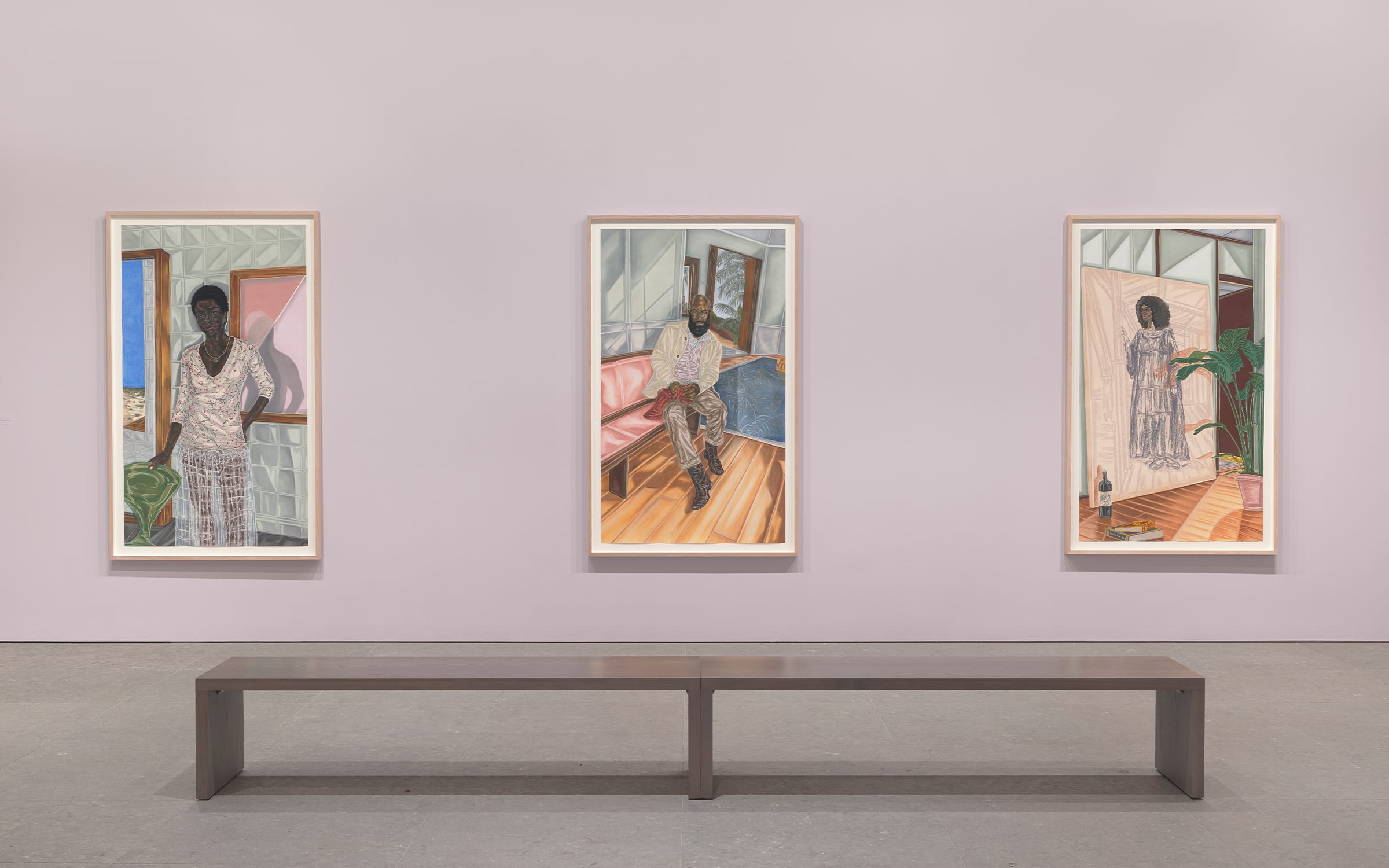
Such complex, fictional narratives reoccur regularly in the artist's practice. In ‘A Countervailing Theory’, at the Barbican Centre, London in 2020, Ojih Odutola created a suite of stark yet sensuous monochromatic images depicting a prehistorical matriarchal civilization, inspired by the landscapes of her native country. She calls the speculative exploration in her practice ‘a Queering activity.’ Zadie Smith, writing in British Vogue in 2018, described Ojih Odutola’s work as an ‘Afroternative’, remarking that ‘there has been a departure from the social realism once expected of Black artists, and a move toward the liberty of imagining other possible worlds, a radical and essential freedom in these times.’
Artists Sedrick Chisom (b. 1989, Pennsylvania, US) and Umar Rashid (b. 1976, Illinois, US) also create alternate realities. And while Ojih Odutola’s work leans towards utopia, Chisom and Rashid dip into bleaker speculative territory. Chisom depicts apocalyptic scenarios in which people of color have left Earth following climate catastrophe, endemic disease, and nuclear disaster. His haunting, vibrant canvases, frequently scraped and reworked, combine thermal-vision palettes, spiritual imagery, and historical and sci-fi references.
Over email, Chisom explained that in his paintings, ‘horrors are visited on white people in North America, whose only salvation would be to cling to a story imposed in their head – a myth of whiteness that contradicts the bodily mutation event happening to them all.’ In his paintings, the remaining ‘wypipo’ on Earth undergo a moral and social crisis when their skin pigment begins to darken. He hopes to provoke ‘a moral reckoning with Western indifference’ to current calamities by depicting a fictional dystopia.
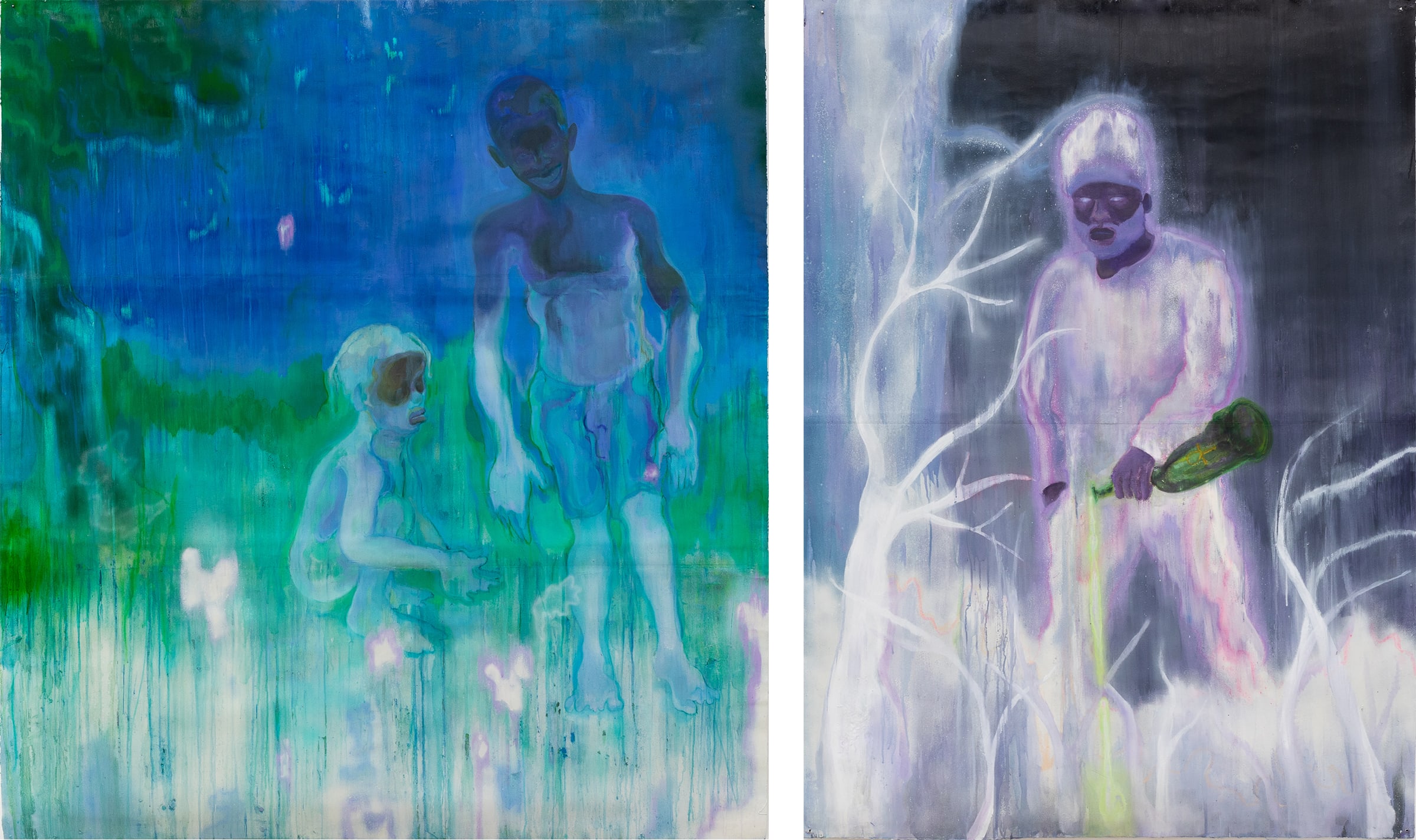
Rashid, who has adopted the moniker Frohawk Two Feathers, has been reworking history painting with wild leaps of imagination for nearly 20 years. He primarily illustrates the bloody battles and triumphs waged around the world by the fictional Frenglish empire between the years of 1658 and 1880. Rashid’s approach has been likened to ‘critical fabulation’, a term associated with the work of American writer Saidiya Hartman. By combining fiction, theory, and archival material, Rashid and Hartman both highlight the voices and stories of historically marginalized people, which may only be partially revealed through official accounts and documents.
Rashid explained in a phone call that the 17th, 18th, and 19th centuries reflect the present: ‘There’s no difference between the age of colonialism and now. We are mirroring societies.’ While he inserts Black people into global narratives where they were once excluded – a pointed correction to his Eurocentric historical education as a youth growing up in Chicago – his work depicts equal-opportunity violence with Hollywood-style beheadings, laser beams, and vengeful ghosts. He sees a Monty Python-esque farcical quality in his practice, saying: ‘The object of the work is not to threaten; it’s to draw people in. Everybody’s present.’ He adds, ‘We love to create heroes and villains, but the world is not black and white. The world is gray.’
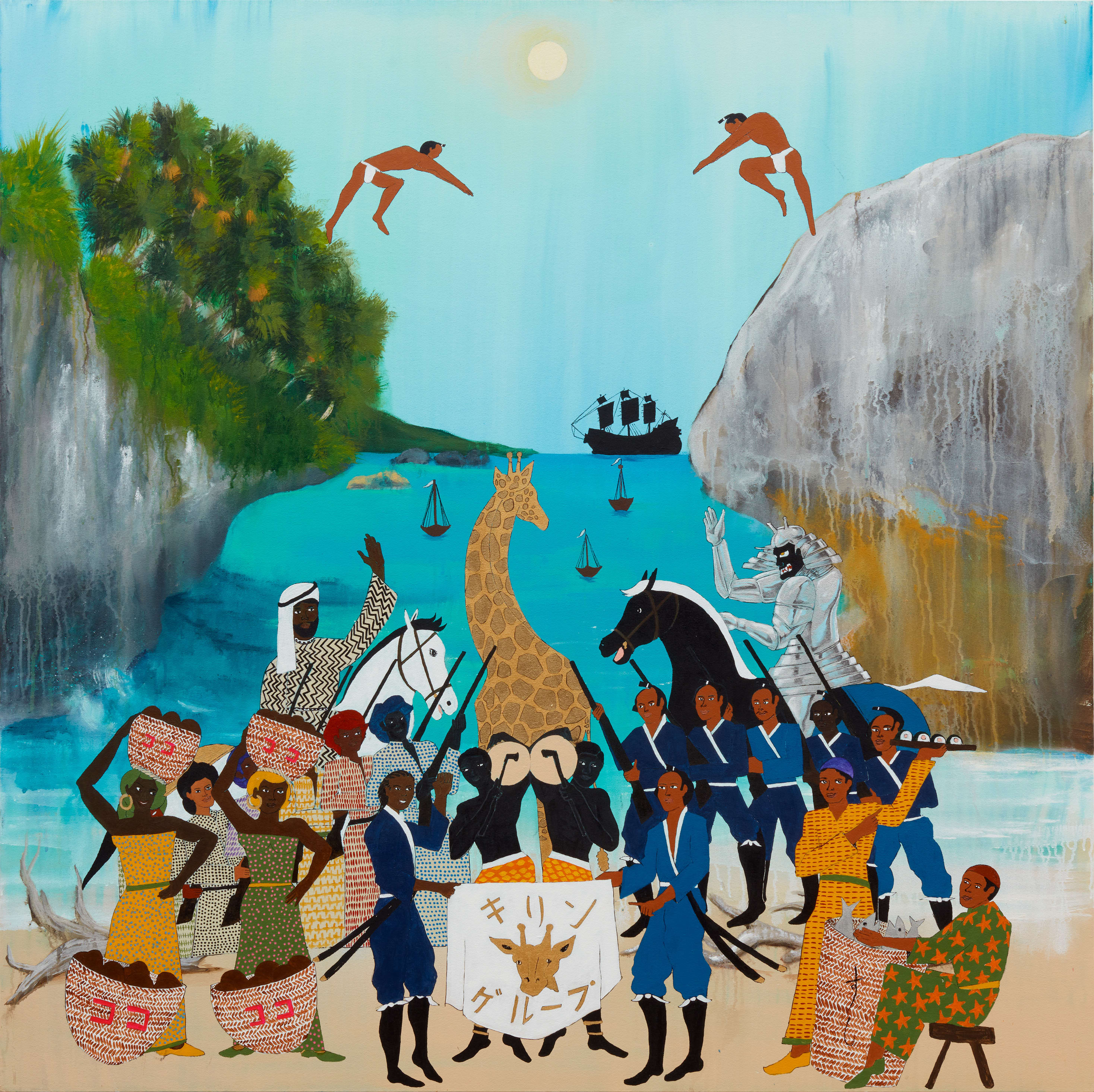

Julie Buffalohead (b. 1972, Minnesota, US), a biracial Indigenous artist and member of the Ponca Tribe of Oklahoma, often allegorizes the Native American experience in her paintings, drawings, and prints. Her motifs include anthropomorphic animal figures such as raccoons and coyotes, as well as designs from traditional ribbon work. In an email, she wrote, ‘I am drawn to universal themes, such as the belief of being a good person, doing right by others, trickster stories, and stories that have a consequence or a learning moment.’ Although her pieces are steeped in personal symbolism, Buffalohead said she does not expect the audience to puzzle out every reference.
Her recent work includes a diptych based on the ‘Haudenosaunee (Iroquois) creation myth of the sky woman,’ featuring a central birthing figure surrounded by helping animals. Using symbolic animals to reflect on the erasure of Native American people and their culture, Buffalohead’s work celebrates the rich narrative tradition of folktales. At the same time, her work pointedly addresses the censure of Native languages and spiritual practices.
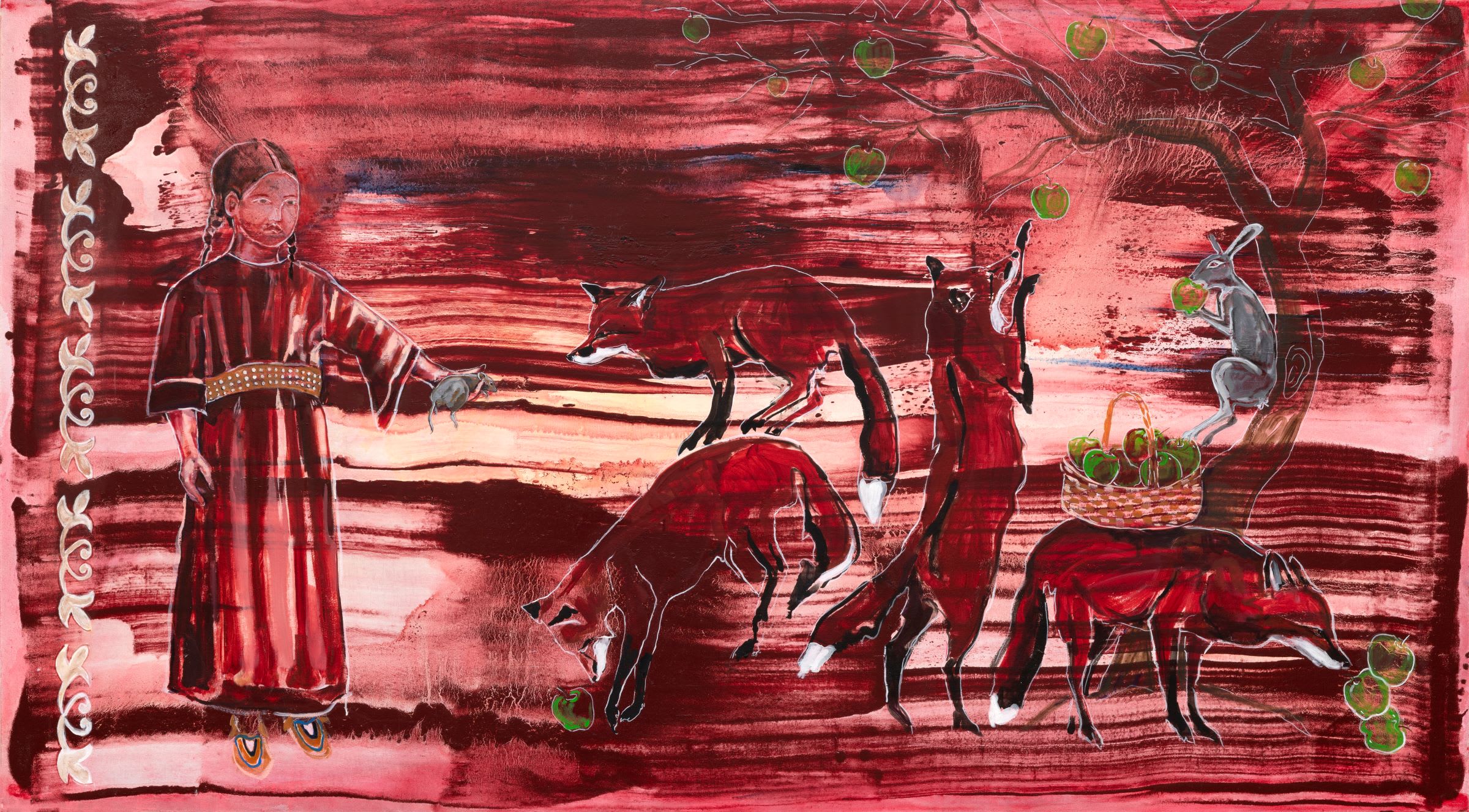
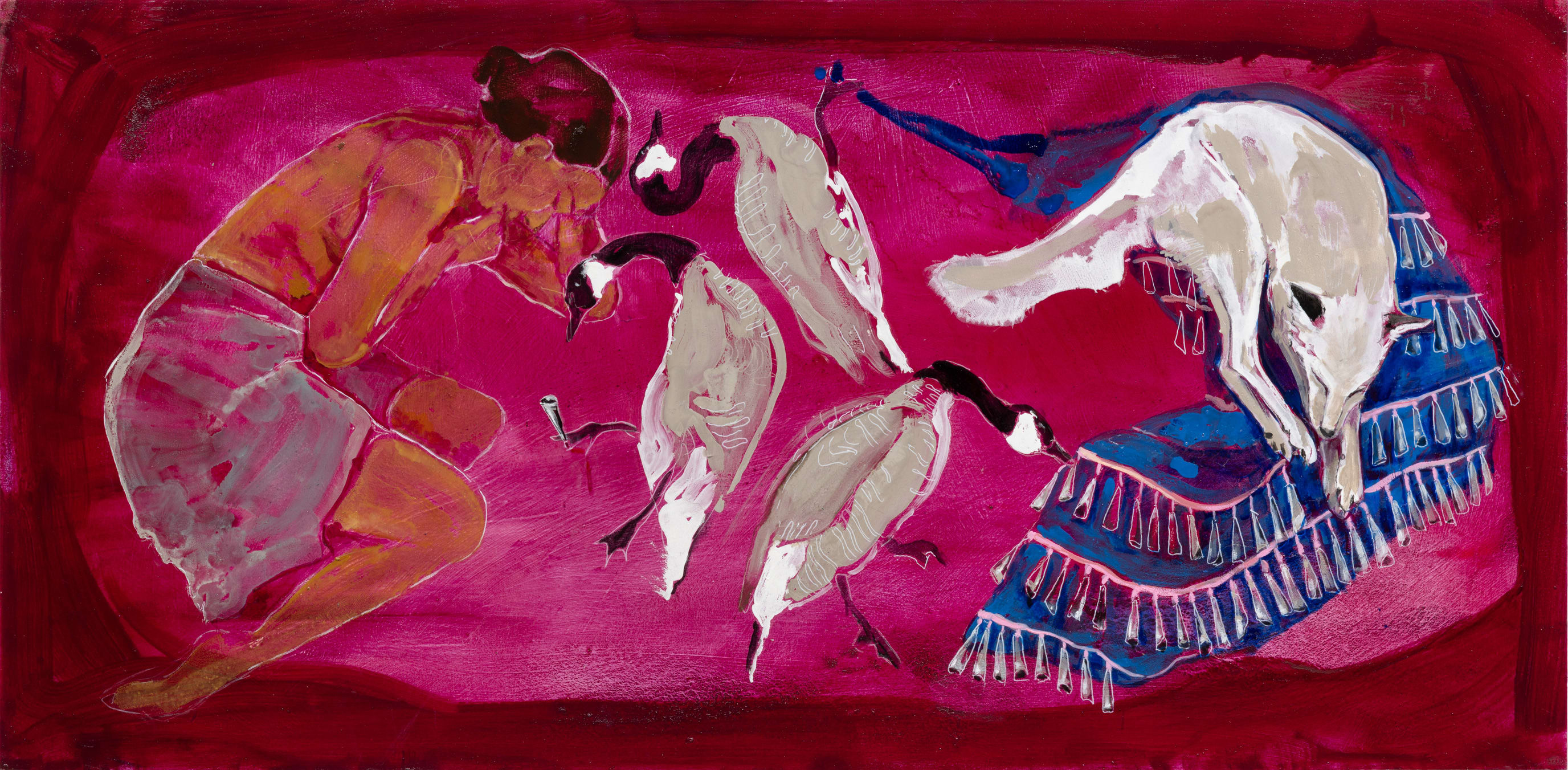
There is a syncretic character to all these artists’ works. Like world-builders in literature and film, they study a wide variety of sources across time and geographical regions. For some artists, research fills in historical gaps. Buffalohead explains that ‘the Ponca have a limited number of historically documented stories collected, because of the diaspora and disruption when the tribe was removed from Nebraska and force-marched to Oklahoma in 1877.’ The daughter of a prominent historian of Native American history, she researches various Indigenous nations extensively. Her sources include myths from North American, Great Lakes, and Plains tribes, as well as scholarly texts such as The Ponca Tribe (1965) by James H. Howard, Art of the Osage (2004) by Garrick Bailey and Daniel C. Swan, and Robin Wall Kimmerer’s Braiding Sweetgrass (2013).
These artists also often produce writing alongside their work. In the leadup to the UmuEze Amara/Obafemi family series, Ojih Odutola wrote timelines and family trees, and kept a journal of her own thoughts about the developing work. Chisom produced a more unusual form of writing for his MFA thesis in painting – a 60-page play (which he still wants to stage) based on several works. Today, the artist does not write text for his shows; however, he titles his pieces with phrases that are ‘uncomfortably to comically to neurotically long,’ repeating awkward, anachronistic key terms like ‘miasmic asscrack hours’, ‘savage south’, and ‘revitiligo’.
A voracious consumer of texts and image, Chisom says he has a video clip or photo at the ready for any conversation. His textual references include classic science-fiction and dystopian titles like Octavia Butler’s Parable of the Sower (1993), Star Trek, Joseph Conrad’s The Heart of Darkness (1899), and Francis Ford Coppola’s Apocalypse Now (1979), as well as historical tomes including The History of White People (2010) by Nell Irvin Painter and The Monstrous Races in Medieval Art and Thought (2000) by John Block Friedman.
Rashid’s passion for writing stems from his background in theater, hip-hop, poetry, and photography. Like Chisom, he also pens absurdly long titles for his paintings, as well as accompanying texts of five to fifteen pages per exhibition. Today, Rashid describes his artistic process as six months of research, followed by six months of production. He mines a wide variety of material for each show, from pre-Roman history to texts about the Kenyan Maasai people to information about crop rotation.

He often turns to centuries-old sources scanned in the digital Project Gutenberg – including texts with incendiary racial epithets – along with books about ‘general warfare applications,’ such as 19th-century Prussian general Carl von Clausewitz’s On War. He describes his long-term project as depicting ‘all possible futures,’ as well as history’s cyclical nature.
Imagination has always been as powerful as a political tool as it is as an artistic one. These artists harness the power of fiction and allegory to produce visually arresting works that critically engage with societal issues. In their intricately drafted worlds, they envision prospective futures. By creating an alternate world – like the best sci-fi writers and filmmakers – they illuminate even more clearly what the history (or the present) has overlooked.
Toyin Ojih Odutola is represented by Jack Shainman Gallery (New York, Kinderhook). Sedrick Chisom is represented by Matthew Brown (Los Angeles) and Pilar Corrias (London). Umar Rashid is represented by Blum (Los Angeles, New York, Tokyo). Julie Buffalohead is represented by Jessica Silverman Gallery (San Francisco).
Captions for full-bleed images, from top to bottom: 1. Sedrick Chisom, Meanwhile a Goblin Giant Waited Within A Nautical Mile of the Wetlands of the Capital Citadel Quietly with His Hipshooter (detail), 2022. © the artist. Courtesy of the artist and Matthew Brown. Photography by Ed Mumford. 2. Detail of a work by Toyin Ojih Odutola, presented at Paris+ par Art Basel 2023 by Lévy Gorvy Dayan. 3. Sedrick Chisom, Untitled (detail), 2022. © the artist. Courtesy of the artist and Clearing. Photography by JSP Art Photography. 4. Installation view of ‘Toyin Ojih Odutola: To Wander Determined’, Whitney Museum of American Art, New York, October 2017 – February 2018. Courtesy of Whitney Museum of American Art.